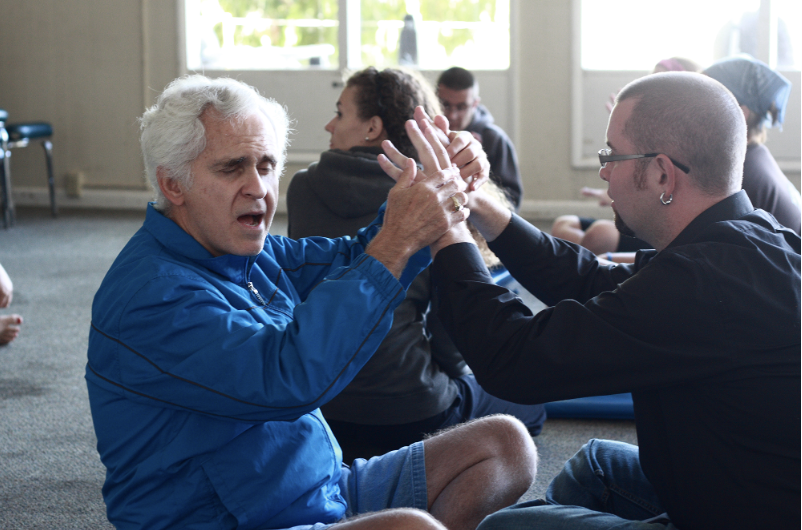(Image: A man who is deafblind sits and works with a Support Service Provider as they communicate using tactile signing. Photo from The Lighthouse for the Blind.)
In the quiet corners of our communities, many people with dual sensory loss—both hearing and vision—face profound isolation, but have a lifeline that opens the doors to participation in the greater community. For them, Support Service Providers (SSPs), also known as Conavigators or CNs, are more than just helpers; they are the crucial link to the world. These specially trained professionals provide the sensory information and communication support that allows deafblind individuals to navigate their surroundings and engage with life more fully.
The Benefits of SSP Services

A deafblind man works with a Support Service Provider. Photo from Hellen Keller Services.
Imagine the world of a person who is both deaf and blind. Everyday tasks become monumental challenges without someone to describe the environment, guide them safely, or facilitate communication. This is where SSPs step in. Unlike caregivers, SSPs do not assist with daily living tasks; instead, they empower their clients by providing vital sensory information. They describe the layout of a room, the faces and actions of people, and even the details of objects. They guide their clients through unfamiliar spaces and translate the visual and auditory experiences of the world into understandable bits of information. Through sign language, tactile signing, or spoken language relays, SSPs bridge the communication gap, enabling their clients to interact with the world around them.
The benefits of having an SSP are immeasurable. They offer deafblind individuals the opportunity for Independent Living that might otherwise be out of reach. With an SSP by their side, these people can pursue education, employment, and social activities, breaking the barriers that their dual sensory loss imposes. Social interactions, often daunting without support, become opportunities for meaningful connections. The presence of an SSP can boost the confidence and self-esteem of individuals, knowing they have a trusted ally to help them navigate their world. SSP services are imperative for people with dual sensory loss to live to their highest potential. Read this previous article to learn exactly how SSPs support deafblind individuals.
Current Challenges Facing SSP Services
The reality of accessing SSP services is extremely challenging. There is a shortage of services tailored specifically for those who are deaf-blind. Historically, support has been divided either to services for either the deaf or the blind, but rarely addressing the unique needs of those with both disabilities. This gap has left many people struggling in silence.
Recently, the situation took a bad turn when the Colorado Commission for the Deaf, Hard of Hearing, and DeafBlind (CCDHHDB), the primary funder of SSP services in Colorado, announced it had run out of funding and had to halt its support. This announcement was devastating for the deafblind community, many of whom rely heavily on SSPs to maintain their independence. There was a temporary reinstatement of these services in December that will go through June 2024, secured through a partnership with the Colorado Cross-Disability Coalition (CCDC). They will provide 18 hours per month of SSP services, which is very minimal. This temporary reinstatement offered a glimmer of hope, but will soon be ending.
Currently there is a waitlist for SSP services in Colorado that stretches up to five years. This lengthy wait discourages many from even applying, exacerbating the isolation of those who might benefit most. Nearly 1,200 Coloradans identify as deaf-blind. The need for advocacy has never been more urgent.
Advocacy groups are working to secure permanent funding and expand services. Direct communication with the Department of Human Services, which oversees the commission, is a key strategy. Feedback from the deafblind community is being channeled to lawmakers to bring awareness to the critical nature of these services.
 In the face of mixed messages from the commission, these advocates are demanding greater accountability and transparency. They are ensuring that the voices of those most affected are heard loud and clear. The goal is not just to maintain current services but to expand and improve them so that no deafblind individual has to live in isolation or be forced into a nursing home due to a lack of support. However, currently there are no bills in legislation to address this issue.
In the face of mixed messages from the commission, these advocates are demanding greater accountability and transparency. They are ensuring that the voices of those most affected are heard loud and clear. The goal is not just to maintain current services but to expand and improve them so that no deafblind individual has to live in isolation or be forced into a nursing home due to a lack of support. However, currently there are no bills in legislation to address this issue.
Support Service Providers are more than a temporary solution; they are a lifeline for the deafblind community. The ongoing advocacy and efforts to secure funding and raise awareness are critical to ensuring that these vital services continue. By bridging the gap between sensory limitations and the world, SSPs empower deafblind individuals to live independent, fulfilling lives, making the world a more inclusive place.
If you need assistance with resources or referrals, independent living skills training, or other independent living support, please contact CPWD: [email protected]





